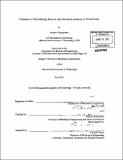| dc.contributor.advisor | Paul D. Sclavounos. | en_US |
| dc.contributor.author | Nanopoulos, Andrew | en_US |
| dc.contributor.other | Massachusetts Institute of Technology. Dept. of Mechanical Engineering. | en_US |
| dc.date.accessioned | 2012-11-19T19:19:34Z | |
| dc.date.available | 2012-11-19T19:19:34Z | |
| dc.date.copyright | 2012 | en_US |
| dc.date.issued | 2012 | en_US |
| dc.identifier.uri | http://hdl.handle.net/1721.1/74932 | |
| dc.description | Thesis (S.M.)--Massachusetts Institute of Technology, Dept. of Mechanical Engineering, 2012. | en_US |
| dc.description | Cataloged from PDF version of thesis. | en_US |
| dc.description | Includes bibliographical references (p. 221-225). | en_US |
| dc.description.abstract | As energy becomes an increasingly important issue for generations to come, it is crucial to develop tools for valuing and understanding energy projects from an economic perspective since ultimately only economically viable solutions will be pushed forward. A model is developed for valuing a generic offshore floating wind farm from a corporate finance perspective. The model is used to value the project based on multiple valuation metrics and to generate sensitivity analyses on multiple important technical, cost and financial parameters. It is found that offshore wind projects can be economically viable under current conditions contingent on high annual mean wind speed and government support. In addition, it is also found that financial parameters prove to be equally or even more important than technical parameters in affecting the overall project value. Furthermore, the wind speed and power output are modeled using a mean reverting Ornstein - Uhlenbeck process whereby it is found that while wind speed is positively autocorrelated, the averaging period plays an important role in determining the nature and extent of the autocorrelation. Finally, the valuation is extended and generalized to a Black-Scholes option based valuation of any project whose underlying asset follows a mean reverting process, whereby a model is developed to find the debt and equity values under the assumption of time independence. The tools developed for this purpose can prove to be useful in other applications besides energy, such as shipping and commodities, as the underlying characteristics of energy projects are often similar across other markets. | en_US |
| dc.description.statementofresponsibility | by Andrew Nanopoulos. | en_US |
| dc.format.extent | 225 p. | en_US |
| dc.language.iso | eng | en_US |
| dc.publisher | Massachusetts Institute of Technology | en_US |
| dc.rights | M.I.T. theses are protected by
copyright. They may be viewed from this source for any purpose, but
reproduction or distribution in any format is prohibited without written
permission. See provided URL for inquiries about permission. | en_US |
| dc.rights.uri | http://dspace.mit.edu/handle/1721.1/7582 | en_US |
| dc.subject | Mechanical Engineering. | en_US |
| dc.title | Valuation of wind energy projects and statistical analysis of wind power | en_US |
| dc.type | Thesis | en_US |
| dc.description.degree | S.M. | en_US |
| dc.contributor.department | Massachusetts Institute of Technology. Department of Mechanical Engineering | |
| dc.identifier.oclc | 815948886 | en_US |
